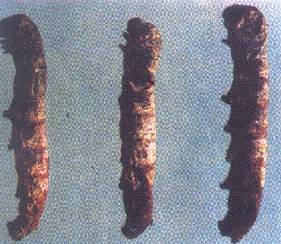DISEASES OF MULBERRY SILKWORM
- Viral Disese
- Bacterial Diseases
- Fungal Diseases
- Protozoan disease : Pebrine
1. Viral Disese
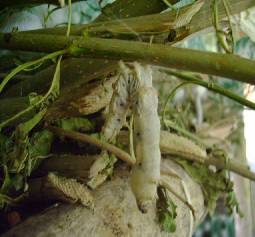
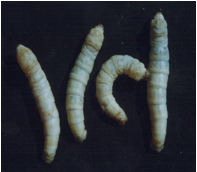 |
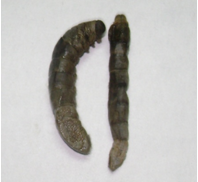 |
| Grasserie |
Flacherie |
Symptom:
- The larvae will be sluggish with swollen intersegmantal region
- The integument of diseases larvae will be fragile and brakes easily
- On infury milky fluid containing many polyhedral inclusion bodies oozes out from the larval body
- The diseases larvae do not settle for moult and showshining integument
- The larvae appear to be restless
- The dead larvae hand by hind legs head downward
Management
- Sun drying of rearing appliances for one/two days
- Disinfection of rearing room and appliances with 5% bleaching powder
- Disinfection of worms, trays and discarding of diseased worms
- Ensure proper ventilation and air circulation
- Provide proper bed spacing
- Feed the larvae with nutritious mulberry leaves
- Collect and burn infected larvae, faecal matter and bed refuses
- Early diagnosis and rejection of infected lots
- Dust the bed disinfectant, Vijetha (or) Resham Keet Oushadh on the larvae, after each moult and ½ hr. before resumption of feeding (3 kg/100 dfl).
- Spray 1% of extract of Psoralea coryleifolia on mulberry leaves, shade dry and feed worms once during third instars.
2. Bacterial Diseases
Bacteria and viruses cause the disease individually or in combination. Fluctuating temperature and humidity and poor quality mulberry predispose the disease development.
- The diseased larvae will be stunted in growth, dill lethargic soft and appear flaccid
- The cephalothoracic region may be translucent
- The larvae vomit gut juice, develop dysentery and excrete chain type fecus.
- The larvae on death putrefy, develop different and emit foul smell
Management
- Maintenance of hygienic condition
- Disinfection of rearing room and appliances
- Disinfection of worms, trace and discarding of sick worms
- Avoid injury to the worms, overcrowding of trays and accumulation of faeces in the rearing bed
- Sound management, improving the rearing environment and feed stuff
- Feeding the larvae with healthy nutritious leaves.
- Early diagnosis and rejection of infected lots
- Avoid spraying commercial B. t. insecticides in nearby mulberry field.
- Apply antibiotics like Streptomycin/Tetracyclin/Ampicillin
3. Fungal Diseases
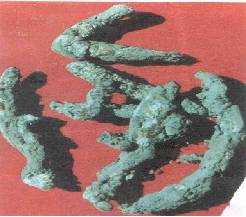
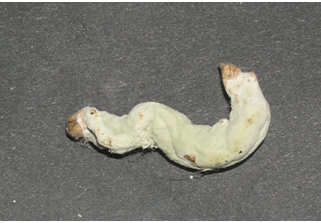 |
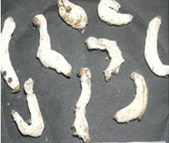 |
Muscardine |
White muscadine is caused by a fungus Beauveria bassiana and the green muscadine is caused by a fungus Spicaria prasina. Aspergillosis is common in young age silkworms and the infected larvae will be lustrous and die. Dark green (Aspergillus flavus) or rusty brown ( Aspergillus tamari)mycelial cluster are seen on the dead body.
- The diseases larvae prior to death will be lethargic and on death are flaccid
- oil specks may be seen on the surface of larvae
- They gradually be fome hard, dry and mummify into a white or green coloured structure
- The diseases pupae will be hard, lighter and mummifies
Magagement
- Sundry the rearing appliances.
- Disinfect the rearing room and utensils with 5 per cent bleaching powder
- Avoid low temperature and high humidity in the rearing room
- Keep the rearing bed thin and dry
- Early diagnosis and rejection of infected lots
- Apply Dithane M45 (3 kg/100 dfls) / Vijetha supplement as disinfectant on the larvae
- Disinfect rearing rooms and trays with 4 per cent pentachlorophenol to control Aspergillosis.
4. Protozoan disease : Pebrine
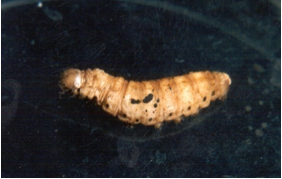 |
Pebrine |
- Diseases larvae show slow growth, undersized body and poor appetite.
- Diseases larvae reveal pale and flaccid body. Tiny black spots appear on larval integument.
- Dead larvae remain rubbery and do not undergo putrefaction shortly after death.
Management of Pebrine
- Produce healthy eggs
- Disinfection of rearing room and utensils
- Maintain strict hygienic conditions during rearing
- Surface disinfect the layings in 2 per cent formalin for 10 minutes before incubation.
- Collect and burn the diseased eggs, larvae, pupae and moths, bed refuses, faecal pellets, etc
|

